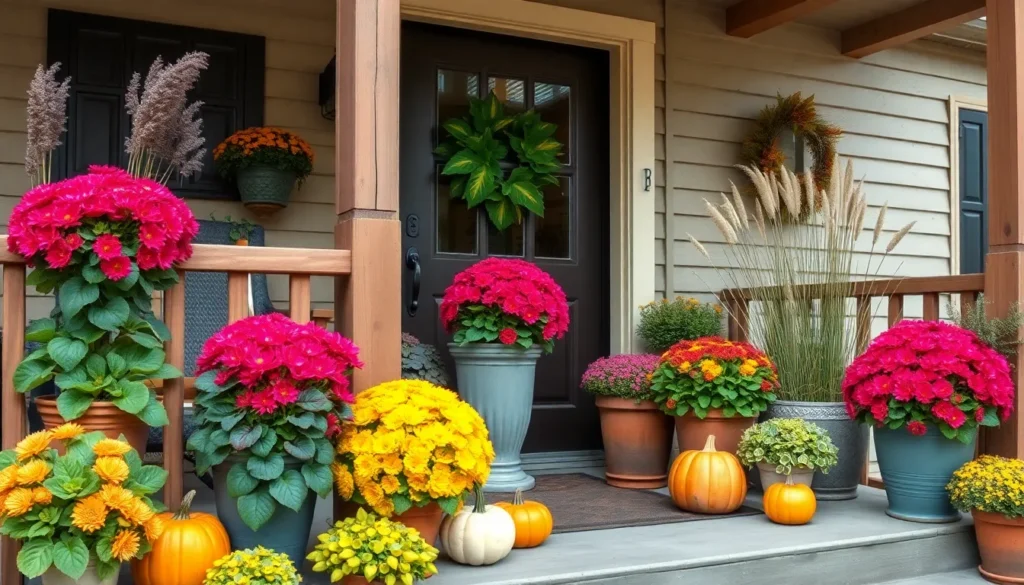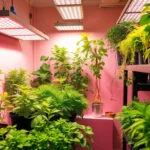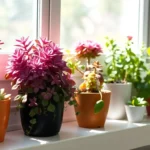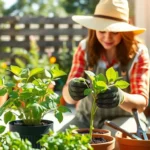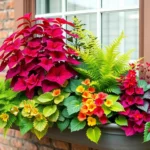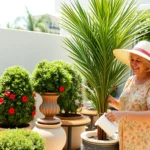As autumn arrives and crisp air begins to fill our days, we’ve got the perfect opportunity to transform our front porches into stunning seasonal showcases. Fall potted plants offer an effortless way to create curb appeal that’ll make neighbors pause and admire our homes. From vibrant mums and ornamental kale to dramatic ornamental grasses, these versatile containers become instant focal points that capture autumn’s rich beauty.
We know that choosing the right fall plants can feel overwhelming with so many gorgeous options available. That’s why we’ve put together this comprehensive guide to help you select, arrange, and care for the perfect potted plants that’ll thrive throughout the season.
Whether you’re working with a sprawling wraparound porch or a modest front stoop, we’ll show you how to create breathtaking autumn displays that welcome guests and boost your home’s charm. Let’s jump into the industry of fall container gardening and discover how these seasonal beauties can elevate your outdoor space.
Choose the Perfect Fall Containers for Your Front Porch Display
Container selection sets the foundation for your entire fall porch display. We recommend choosing vessels that complement your home’s architecture while providing adequate space for root development. Traditional materials like ceramic, terracotta, and concrete offer durability and classic appeal for autumn arrangements.
Size matters significantly when selecting fall containers for front porch displays. Large planters measuring 16-24 inches in diameter accommodate multiple plants and create substantial visual impact. Medium containers between 12-16 inches work perfectly for single specimen plants like ornamental kale or dwarf mums. Small accent pots under 12 inches serve as excellent supporting elements for layered arrangements.
Material choice influences both aesthetics and plant health throughout the fall season. Ceramic containers provide excellent insulation for root systems during temperature fluctuations. Fiberglass planters offer lightweight portability while maintaining weather resistance. Natural materials like whiskey barrels and woven baskets add rustic charm that complements autumn themes.
Drainage requirements become critical for fall potted plants as seasonal rainfall increases. We always select containers with multiple drainage holes to prevent waterlogged soil conditions. Elevating planters on pot feet or decorative stands improves air circulation and prevents water damage to porch surfaces.
Color coordination enhances the overall visual impact of your fall container display. Earth tones like terracotta, deep brown, and sage green complement autumn foliage naturally. Neutral colors such as cream, gray, and charcoal provide versatile backgrounds that highlight colorful fall plants. Bold accent colors like burgundy or navy can create striking focal points when used sparingly.
Grouping containers effectively creates ever-changing visual interest on front porches of any size. We arrange planters in odd numbers using the triangle principle for balanced compositions. Varying heights through plant stands, stacked containers, or tiered arrangements adds depth to flat porch spaces. Mixed container sizes prevent monotonous displays while maintaining cohesive design elements.
Select Hardy Fall Plants That Thrive in Cooler Weather
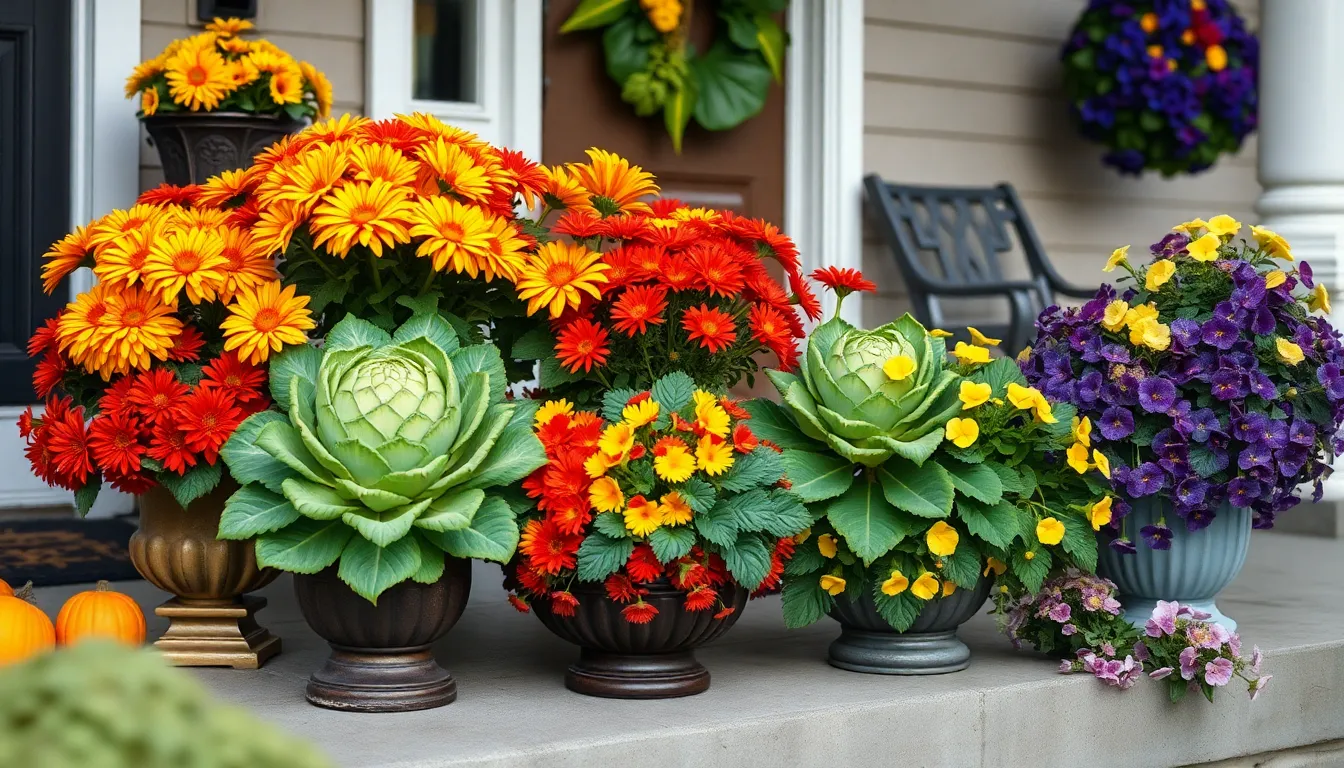
Building on your container selection, we’ll explore the best plant choices that can withstand autumn’s dropping temperatures while maintaining their beauty throughout the season.
Chrysanthemums for Classic Autumn Color
Chrysanthemums serve as the perfect focal point for your fall container arrangements. Garden mums offer vibrant colors including yellow, orange, red, and purple that capture autumn’s essence beautifully. These hardy plants provide long-lasting blooms throughout the entire fall season, making them ideal as your container’s main “thriller” element.
We recommend positioning mums as the centerpiece of your arrangement since their full, rounded shape creates excellent visual weight. Their robust nature allows them to withstand cooler temperatures while maintaining their spectacular flower display. Quality potting soil supports their health, and they’ll continue blooming well into late fall with proper care.
Ornamental Kale and Cabbage for Unique Textures
Ornamental kale and cabbage bring exceptional texture and color variety to your fall displays. These plants feature ruffled leaves in stunning combinations of green, white, pink, and purple that create visual interest beyond traditional flowers. Frost tolerance makes them particularly valuable for extending your container’s appeal well into early winter.
We love using these plants as textural elements that complement flowering plants like mums. Their unique leaf patterns provide the “filler” component in your arrangement, creating depth and dimension. Cool weather actually enhances their coloration, making them more vibrant as temperatures drop.
Pansies for Long-Lasting Blooms
Pansies deliver bright, cheerful flowers combined with impressive cold hardiness for extended fall color. These versatile plants bloom for extended periods throughout autumn and serve as excellent “fillers” around taller specimens like mums or ornamental kale. Their compact size makes them perfect for cascading over container edges or filling gaps between larger plants.
We particularly appreciate pansies for their ability to maintain their flowering performance even as other plants begin to fade. Their cheerful faces in various color combinations add personality to your arrangements while providing reliable color that lasts through the season.
Create Stunning Color Combinations with Seasonal Foliage

Building on our plant selection, we’ll explore how to combine these hardy fall varieties into captivating color schemes that transform your front porch into an autumn showcase.
Warm Orange and Red Palettes
Chrysanthemums serve as our foundation for this classic fall combination, with their yellow, red, and orange hues creating vibrant displays as days shorten. Grouping mums together amplifies their impact and establishes that iconic autumn look we’re after.
Pumpkins and gourds in natural orange tones complement these blooms perfectly, improving the warmth while adding seasonal charm to our arrangements. We recommend placing these decorative elements around the base of containers or nestling them between plants.
Bloody Geraniums contribute deeper red tones as their foliage transforms to rich burgundy and brown during autumn months. These perennials add sophisticated depth to our warm palette combinations.
Creeping Jenny provides essential texture contrast with its trailing green foliage that spills over container edges. This hardy ground cover also protects more delicate plants by covering soil and creating natural frost barriers.
Rich Purple and Burgundy Schemes
Pansies and violas excel in purple, burgundy, and magenta arrangements because they tolerate fall’s variable temperatures while adding sophisticated depth. These resilient flowers maintain their vibrant colors even when temperatures fluctuate between warm days and cool nights.
Ornamental kale and flowering cabbage bring elegant burgundy and purple foliage that creates stunning focal points in our arrangements. Their ruffled leaves provide textural interest while their rich colors intensify as temperatures drop.
Accent grasses paired with these purple tones create ever-changing contrast and movement in our displays. We suggest choosing varieties with bronze or golden seed heads that complement the deeper purple hues.
Classic Yellow and Bronze Arrangements
Yellow chrysanthemums mixed with hydrangeas offer soft yet cheerful combinations that brighten autumn porches. These partnerships create gentle contrast while maintaining the warm, welcoming feel we want for fall displays.
Bronze and gold decorative elements like small pumpkins or dried cornstalks enhance yellow blooms naturally. We position these accents strategically to reinforce the golden theme without overwhelming the living plants.
Perennials with bronze or muted foliage ground these arrangements with earthy tones that feel naturally autumn appropriate. These plants provide subtle backdrop colors that allow brighter yellows to shine.
Evergreens create perfect backdrops for these warm color schemes while offering practical frost resistance for our containers. We use them as anchor plants that provide structure and year round interest to our seasonal displays.
Add Height and Structure with Ornamental Grasses
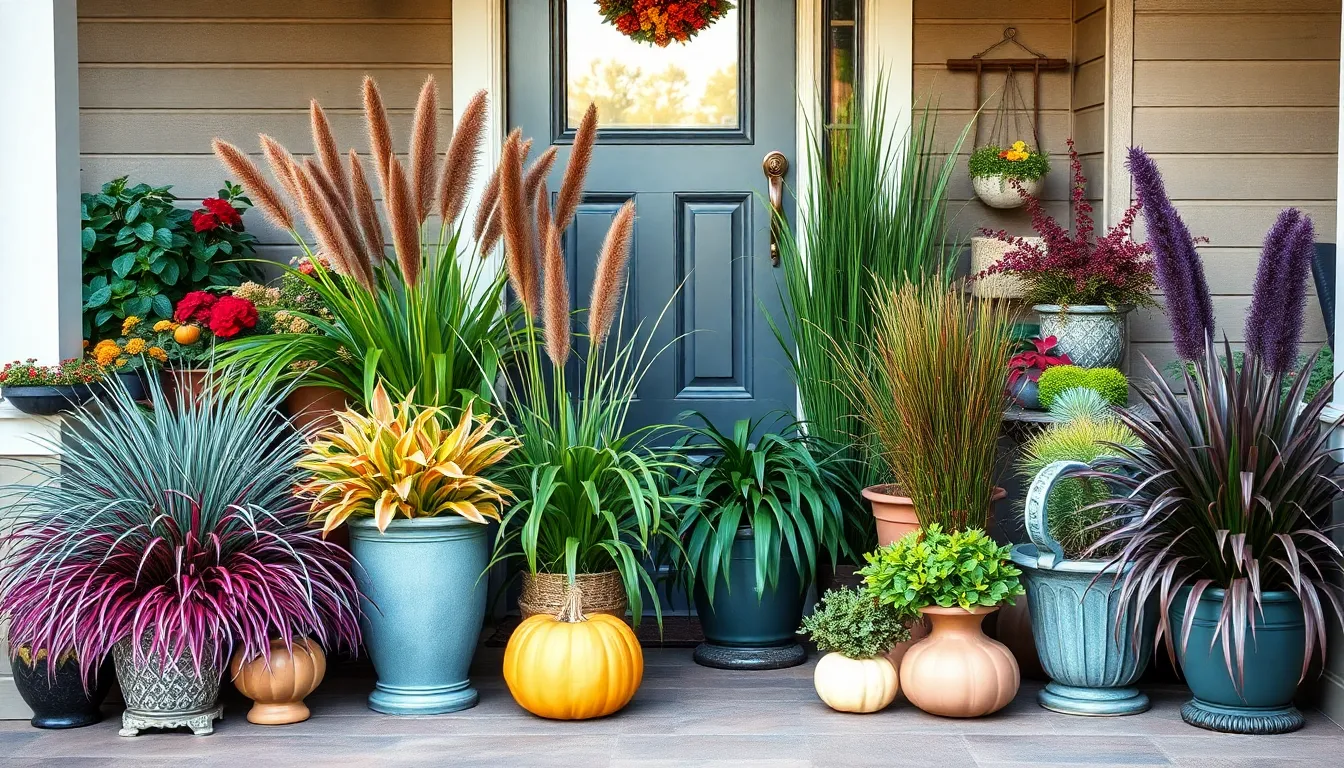
After selecting our vibrant fall plants and color combinations, we can elevate our porch displays by incorporating ornamental grasses that add vertical dimension and graceful movement to our autumn containers.
Fountain Grass for Graceful Movement
Fountain Grass (Pennisetum alopecuroides) creates ever-changing visual interest with its arching foliage that responds beautifully to autumn breezes. We love how this grass adds natural movement to our static fall arrangements, making our front porch displays feel alive and captivating.
Soft, fluffy flower spikes emerge in late summer and persist through fall, creating an elegant silhouette that complements traditional fall flowers like mums and ornamental kale. The graceful arching form serves as a perfect backdrop for shorter seasonal plants, helping us create layered displays with varied textures.
Positioning fountain grass in the back of our containers allows its flowing movement to frame other plants while adding height without overwhelming smaller specimens. This versatile grass works exceptionally well in medium to large planters where it has room to showcase its full, graceful form.
Feather Reed Grass for Vertical Interest
Feather Reed Grass (Calamagrostis x acutiflora ‘Karl Foerster’) delivers strong vertical lines that add impressive height and structure to our fall container gardens. We appreciate how this grass maintains its upright form throughout the season, providing reliable architectural interest.
Tall, slender flower spikes hold their shape exceptionally well through autumn weather, giving us consistent vertical elements that enhance our porch displays’ overall depth and dimension. The rigid structure creates a striking contrast against the softer forms of fall annuals and perennials.
Using feather reed grass as a centerpiece in our largest containers creates instant focal points while allowing us to arrange complementary plants around its base. This approach helps us achieve professional looking displays that maximize visual impact on our front porches.
Purple Fountain Grass for Color Impact
Purple Fountain Grass (Pennisetum setaceum ‘Rubrum’) stands out dramatically with its deep purple foliage and matching inflorescences that create bold color statements in our fall arrangements. We find this grass particularly effective for adding rich, dark tones that complement traditional autumn colors.
Deep purple coloring provides stunning contrast against the warm oranges, reds, and yellows commonly found in seasonal flowers like chrysanthemums and ornamental kale. This dramatic pairing helps us create visually striking displays that capture attention from the street.
Combining purple fountain grass with complementary plants like asters, ornamental peppers, and creeping jenny gives us lush, textured arrangements that maintain color throughout the fall season. The grass serves as an anchor plant that ties together our entire seasonal display while adding sophisticated drama to our front porch décor.
Incorporate Seasonal Elements for Authentic Fall Appeal

Seasonal elements transform ordinary potted plant displays into authentic autumn showcases that capture the essence of fall. These natural accents work harmoniously with your carefully selected plants to create welcoming front porch displays.
Mini Pumpkins and Gourds
Mini pumpkins and various gourds instantly evoke the harvest season when arranged around your potted plants. We recommend placing these quintessential fall accents both around the base of containers and atop soil surfaces to complement your flowering displays. Sometimes we’ll hollow out small pumpkins to serve as creative plant containers themselves, adding unexpected charm to your seasonal arrangements.
These miniature harvest elements work particularly well with chrysanthemums, creating dense and colorful displays perfect for front porches. Grouping different sized gourds together provides visual interest while maintaining the authentic fall aesthetic your guests will love.
Corn Stalks and Wheat Bundles
Corn stalks and wheat bundles lend rustic charm while improving the vertical dimension of your porch displays. We suggest tying these natural elements to pot edges or positioning them behind containers to create impressive height and texture. This approach invokes traditional fall farm imagery that feels both nostalgic and welcoming.
Bundled wheat adds movement and catches autumn breezes beautifully, while corn stalks provide sturdy backdrops for your colorful mums and ornamental plants. These elements work especially well when combined with evergreen perennials like Creeping Jenny, which trails over pot edges and helps unite the entire display.
Colorful Fall Leaves and Branches
Branches featuring vibrant fall foliage in red, orange, and yellow hues add spectacular color depth to your planters. We recommend interspersing these branches among your plants or using them as natural backdrops to highlight your seasonal containers. Fresh or dried leaves and twigs enhance the earthy, authentic feel that makes fall displays so appealing.
Consider using bark mulch or straw around the base inside your pots to unify displays with these natural branch elements. This technique creates cohesive arrangements that blend seamlessly with ornamental peppers, coleus, and other fall plants while maintaining the rustic charm that defines authentic autumn appeal.
Layer Plants at Different Heights for Visual Interest

Layering plants at different heights creates depth and visual impact that transforms ordinary containers into stunning front porch displays. We’ll explore how combining tall backdrop plants, medium focal points, and low-growing ground cover creates ever-changing arrangements that capture attention throughout the fall season.
Tall Backdrop Plants
Ornamental grasses form the perfect backdrop for our fall arrangements, providing vertical height and graceful movement. These tall plants create structure while their feathery plumes add texture and seasonal interest to displays.
Chrysanthemums in taller varieties serve as excellent backdrop options when planted 6-8 weeks before the first frost. We recommend placing these mums in well-draining soil with consistent moisture and sunny spots for optimal blooming. Their rich autumnal colors create the perfect foundation for layered arrangements.
Upright growing specimens like tall asters or ornamental peppers add bold vertical lines to our displays. These plants work especially well when positioned at the back of large containers, creating dramatic silhouettes against porch walls or railings.
Medium-Height Focal Points
Pansies and violas make ideal centerpiece plants that draw the eye with their vibrant purple, burgundy, and yellow blooms. These medium-height beauties tolerate cooler fall temperatures while requiring partial to full sun with well-drained soil and consistent watering.
Ornamental kale and flowering cabbage create striking focal points with their ruffled leaves and unique textures. We love how these plants complement chrysanthemums while providing interesting foliage that intensifies as temperatures drop.
Medium-sized mum varieties work perfectly as attention-grabbing centerpieces in our arrangements. Their compact growth habit and abundant blooms make them ideal for creating visual weight in the middle layer of our displays.
Low-Growing Ground Cover Options
Creeping sedum varieties add texture while filling empty spaces around taller plants in our containers. These low-growing succulents provide interesting foliage colors that complement fall themes while requiring minimal maintenance.
Small pansy varieties work beautifully as spillers that drape elegantly over pot edges. We position these plants to create soft transitions between our arrangements and the porch surface, adding a finished touch to displays.
Trailing ivy or sweet alyssum completes the layered look by contrasting with upright plant forms. These ground cover options soften container edges while adding movement and flow to our fall porch arrangements.
Choose Weather-Resistant Planters for Durability
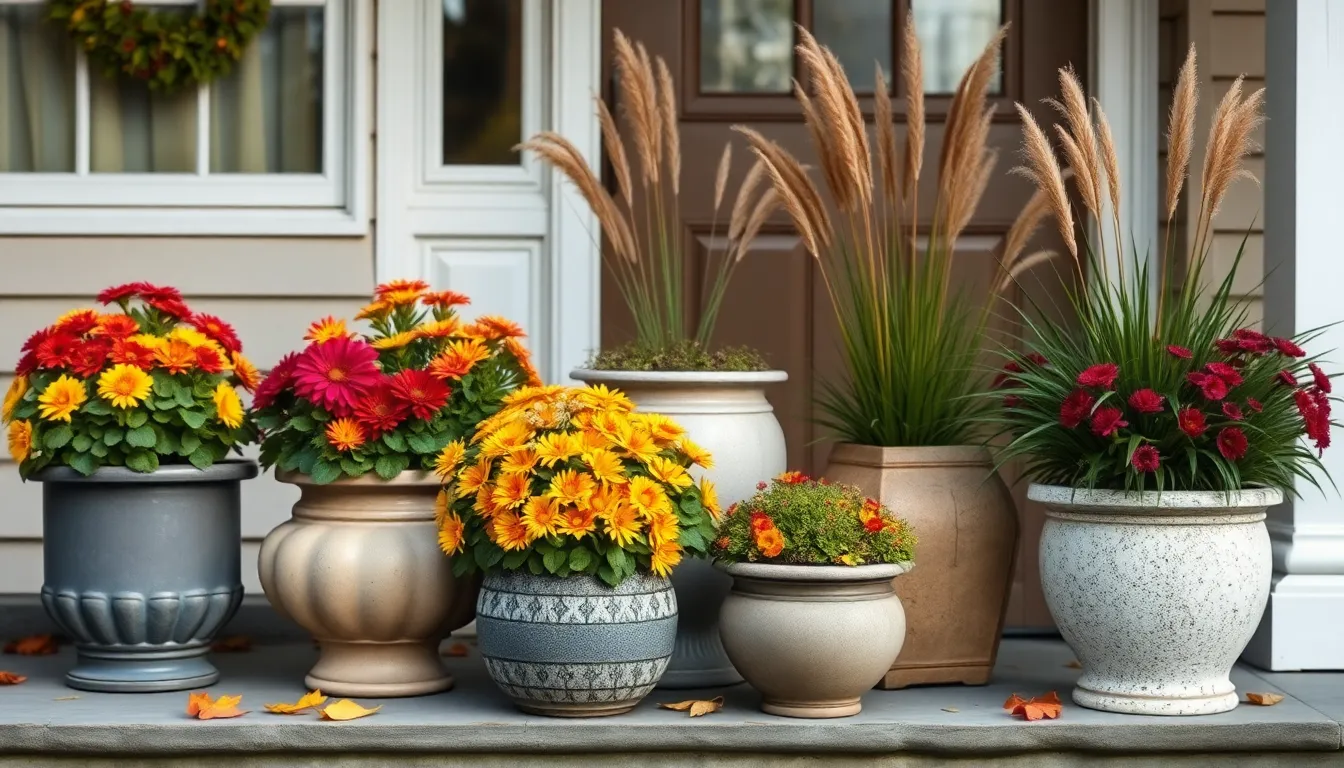
Selecting the right containers becomes crucial when creating stunning fall displays that can withstand autumn’s unpredictable weather patterns. We need planters that protect our investment while maintaining their beauty throughout the season.
Ceramic and Stone Options
Ceramic and stone planters deliver exceptional durability and visual appeal for our fall porch arrangements. These materials provide excellent insulation for plant roots against temperature fluctuations that commonly occur during autumn months. We appreciate how they complement both traditional and modern home architectures while offering substantial weight that prevents containers from tipping in strong fall winds.
Stone planters naturally resist weather damage and develop attractive patina over time. Ceramic options come in countless colors and finishes that coordinate beautifully with our seasonal plant selections. But, we must choose frost resistant varieties or properly sealed containers to prevent cracking during freeze thaw cycles. These heavier materials work best for permanent or semi permanent installations where we won’t need frequent repositioning.
Fiber and Resin Alternatives
Fiber and resin planters offer the perfect blend of durability and practicality for our fall container gardens. These lightweight materials mimic natural textures like wood grain or stone surfaces while providing superior weather resistance. We love how they won’t crack in cold weather conditions that typically damage other planter types.
Resin containers often include UV protection that prevents fading from prolonged sun exposure on our front porches. Fiber planters resist moisture absorption and maintain their structural integrity through wet autumn weather. These materials allow us to easily rearrange our displays as needed without the back strain associated with heavier options. Advanced manufacturing techniques create remarkably realistic finishes that fool even close inspection.
Traditional Wooden Containers
Wooden containers provide timeless charm that perfectly complements our seasonal plantings like chrysanthemums and ornamental grasses. We recommend choosing rot resistant woods such as cedar or redwood for maximum longevity in outdoor conditions. These natural materials age gracefully and develop rich patinas that enhance their rustic appeal over time.
Proper preparation ensures our wooden planters last through multiple seasons of use. We should treat or seal the wood to protect against moisture damage that commonly occurs during fall’s increased rainfall. Drainage holes become essential for preventing root rot and waterlogging issues. Raising wooden containers slightly off the ground using pot feet or blocks prevents direct contact with wet surfaces that accelerate decay. Regular maintenance like annual sealing keeps these classic containers looking their best while protecting our plant investments.
Maintain Your Fall Potted Plants Throughout the Season
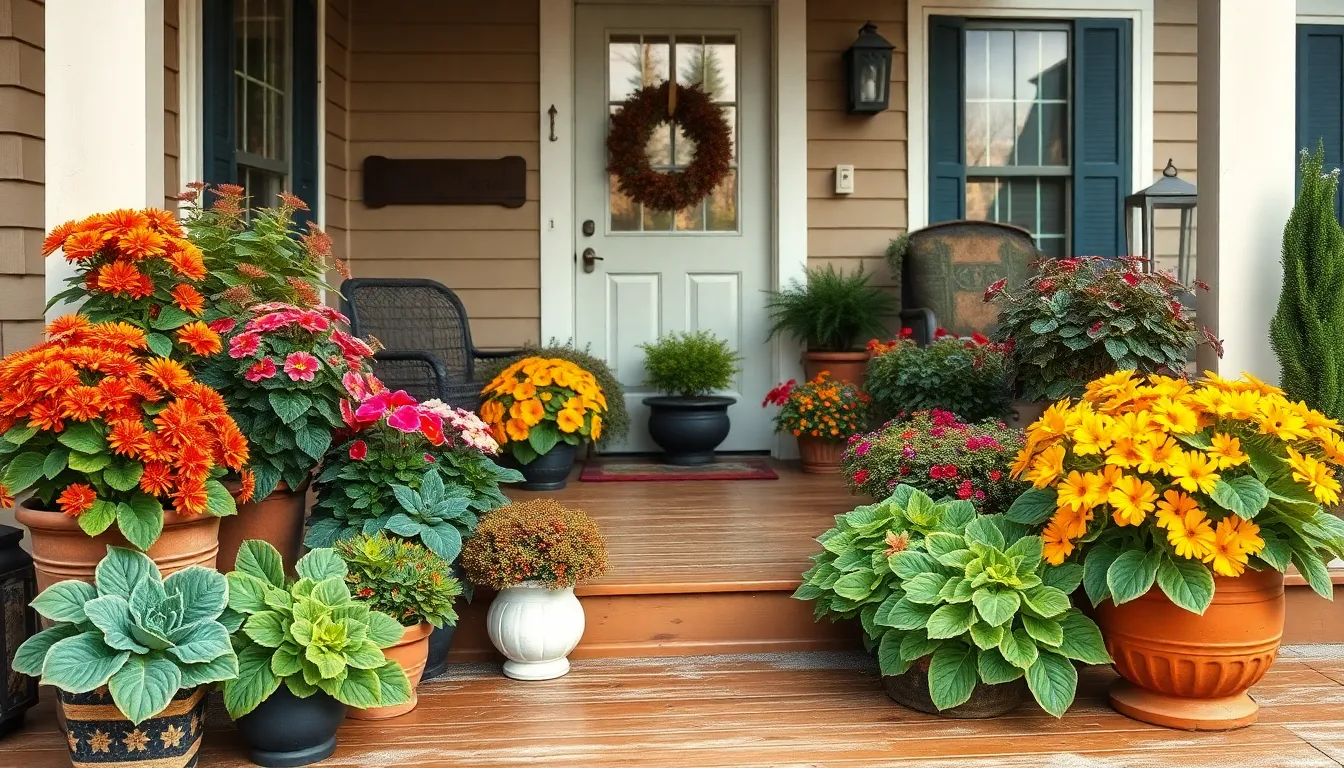
Once we’ve created our stunning autumn displays, we need to adjust our care routine to keep these plants thriving as temperatures drop. Fall potted plants require different maintenance than their summer counterparts.
Proper Watering Techniques
Watering frequency should decrease significantly as cooler temperatures slow plant growth. Fall potted plants typically need water only once or twice per week compared to daily summer watering. We recommend checking soil moisture by inserting your finger into the top inch of soil before watering.
Moisture levels become the primary indicator for watering decisions. Water only when the top inch feels dry to the touch. This prevents overwatering which leads to root rot in cooler fall conditions.
Timing matters more in autumn weather patterns. Water during morning hours to allow plants to absorb moisture before evening temperatures drop. This reduces the risk of water freezing around root systems during unexpected cold snaps.
Fertilizing and Deadheading Tips
Fertilizer applications should be reduced to half strength during fall months. Plant growth naturally slows as daylight hours decrease, so we use balanced liquid fertilizer at 50% recommended strength every 4 to 6 weeks. This supports plants without overstimulating growth that won’t survive winter.
Deadheading spent flowers keeps plants blooming longer throughout the season. Remove faded blooms weekly to encourage continuous flowering on chrysanthemums, pansies, and ornamental kale. This simple task redirects plant energy into producing new flowers rather than seeds.
Slow release fertilizers work best for fall container gardens. These provide steady nutrition without the risk of overfeeding. Apply once at the beginning of fall season for sustained plant health through autumn months.
Protection from Frost and Wind
Frost protection requires monitoring weather forecasts closely during fall months. Move containers closer to your house or under covered porch areas when temperatures drop below 35°F. This simple relocation can raise the temperature around plants by several degrees.
Covering plants with frost cloths or blankets provides overnight protection. Use lightweight fabrics that allow air circulation while blocking frost formation on leaves and flowers. Remove covers during warmer daytime hours to prevent overheating.
Wind protection prevents container drying and plant damage. Position planters in sheltered locations away from strong autumn winds. Create windbreaks using larger containers or temporary screens to shield delicate plants like pansies and ornamental cabbage from harsh gusts.
Strategic placement near your home’s foundation offers natural protection. The warmth radiating from your house creates a microclimate that’s typically 5 to 10 degrees warmer than open areas. This positioning helps extend your fall display season considerably.
Transition Your Display from Fall to Winter
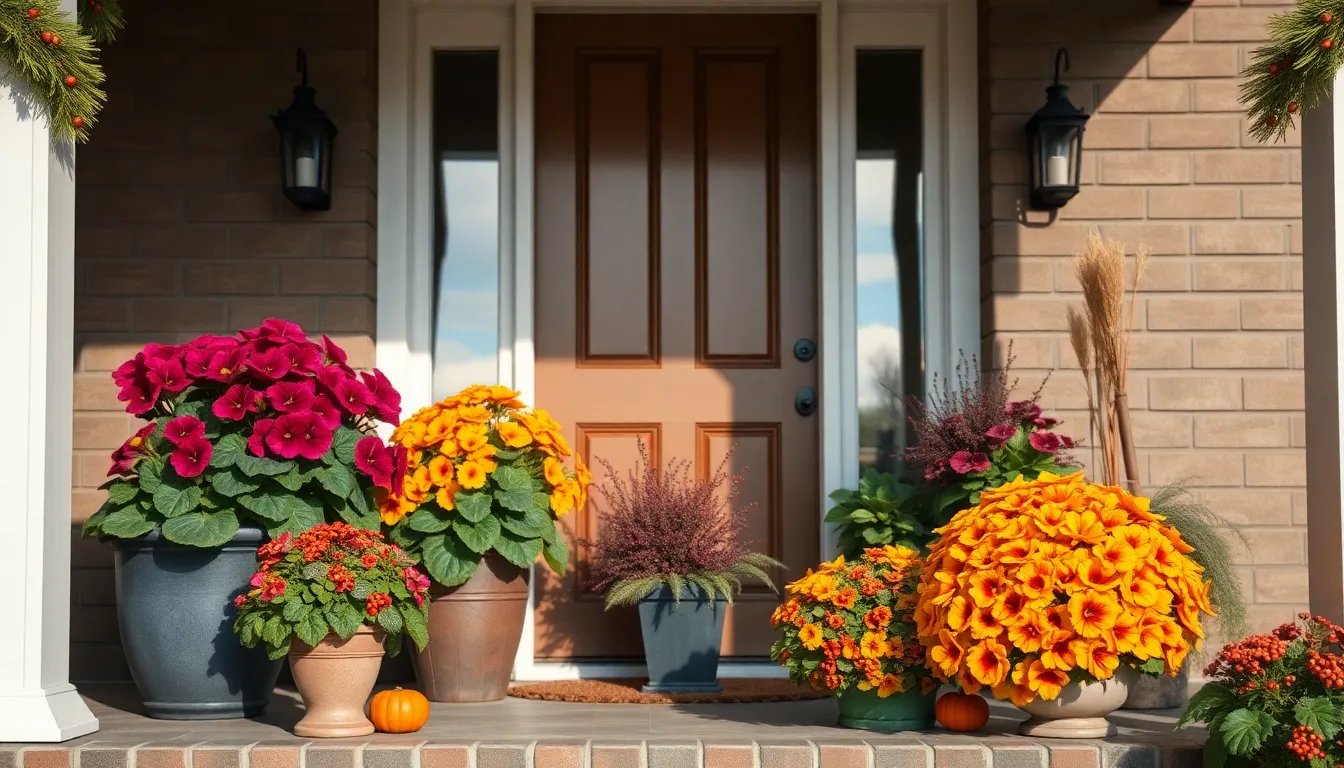
We can extend our porch’s appeal well beyond autumn by selecting the right plants and preparing our displays for colder months. Strategic planning now ensures our front entrance remains welcoming throughout winter’s arrival.
Hardy Plants That Last Beyond Fall
Pansies and violas continue blooming even after frost hits our containers, surviving snow and ice while maintaining their cheerful appearance. These resilient flowers provide consistent color through both seasons, making them essential choices for year-round displays.
Garden chrysanthemums thrive in cool fall weather and often persist into early winter with proper care. We’ll find that certain mum varieties handle temperature drops better than others, particularly when planted in protected areas near our home’s entrance.
Ornamental cabbage and kale offer exceptional cold tolerance while delivering stunning visual impact through winter months. Their ruffled leaves actually become more vibrant as temperatures drop, creating beautiful autumnal displays that last well into the cold season.
Heuchera provides reliable foliage interest in containers during winter months with appropriate protection. We can count on these perennials to maintain their attractive leaf colors even when other plants fade.
Adding Winter Interest Elements
Fir, juniper, and cedar boughs bring natural winter beauty to our existing fall containers without requiring complete redesigns. We simply tuck these evergreen branches between our hardy plants to create instant seasonal transitions.
Holly and magnolia leaves add glossy texture and rich green tones that complement our winter plant palette. These materials work particularly well when arranged around the base of containers or woven through taller plantings.
Decorative twigs and branches provide structural elements that catch snow and create interesting silhouettes against winter skies. We can gather these from our own yards or purchase them from garden centers for consistent, professional looking displays.
Seasonal berries on branches bring pops of red and orange that echo our fall color schemes while adding winter wildlife appeal. These natural accents help bridge the visual gap between our autumn and winter displays.
Preparing Containers for Cold Weather
Insulate our containers by wrapping them with foam, straw, or bubble wrap to protect plant roots from extreme temperature fluctuations. This protective layer prevents the freeze-thaw cycle that damages both plants and pots.
Choose frost resistant materials when selecting new containers, prioritizing ceramic, stone, or high quality resin over materials that crack in freezing temperatures. We’ll avoid terracotta and thin plastic containers that split when water inside them freezes.
Position containers strategically near our home’s foundation or in areas that receive some protection from harsh winds and direct exposure. These microclimates help our plants survive winter’s challenges while maintaining their decorative appeal.
Elevate pots slightly on bricks or pot feet to improve drainage and prevent containers from freezing to our porch surfaces. This simple step protects both our plants and our porch from potential damage during freeze-thaw cycles.
Conclusion
Creating stunning fall potted plant displays for your front porch doesn’t have to be overwhelming. With the right combination of hardy plants weather-resistant containers and seasonal accents you’ll transform your entrance into an inviting autumn showcase that reflects your personal style.
Remember that successful fall displays are all about balance – mixing heights textures and colors while ensuring your plants can thrive in cooler temperatures. The beauty of potted arrangements lies in their flexibility allowing you to adjust and refresh your display as the season progresses.
Your front porch serves as the first impression of your home and with these carefully chosen fall elements you’re creating a warm welcome that celebrates the season’s natural beauty while preparing for the transition into winter.
Frequently Asked Questions
What are the best plants for fall porch displays?
Chrysanthemums, ornamental kale, ornamental cabbage, and pansies are excellent choices for fall porch displays. These plants thrive in cooler weather and offer vibrant colors that last throughout the season. Ornamental grasses like Fountain Grass and Purple Fountain Grass also add height and texture to arrangements while being extremely hardy.
How do I choose the right containers for my fall display?
Select containers that complement your home’s architecture and provide adequate drainage. Large planters work best for multiple plants, medium containers for single specimens, and small pots for accents. Choose durable materials like ceramic, fiberglass, or weather-resistant resin that can withstand temperature changes and autumn weather conditions.
What color combinations work best for autumn porch decorations?
Classic fall color schemes include warm orange and red combinations using chrysanthemums and pumpkins, rich purple and burgundy palettes with pansies and ornamental kale, and traditional yellow and bronze arrangements with yellow mums and bronze accents. These combinations create authentic autumn appeal and visual impact.
How can I add height and structure to my porch display?
Use ornamental grasses like Fountain Grass and Feather Reed Grass as backdrop plants to create vertical interest. Layer plants at different heights by placing tall grasses in back, medium-height plants like mums in the middle, and low-growing ground covers in front. This creates depth and professional-looking arrangements.
What seasonal elements should I incorporate besides plants?
Add mini pumpkins, gourds, corn stalks, wheat bundles, and colorful fall leaves to enhance your display’s autumn appeal. These natural elements work harmoniously with potted plants and can be arranged around containers or even used as creative planters themselves, creating cohesive seasonal decorations.
How do I maintain my fall potted plants throughout the season?
Adjust watering schedules as temperatures drop, protect plants from early frost with covers or strategic placement, and remove spent blooms regularly. Monitor soil moisture carefully since container plants dry out faster than ground plantings, and consider moving containers to sheltered areas during severe weather.
Can I transition my fall display into winter?
Yes, select hardy plants like pansies, violas, and ornamental cabbage that tolerate cold temperatures. Add winter interest elements such as evergreen boughs, holly leaves, and decorative twigs. Insulate containers and move them to protected areas to help plants survive harsh winter conditions while maintaining visual appeal.
What container materials are most weather-resistant for fall displays?
Ceramic, stone, fiberglass, and resin containers offer excellent weather resistance. Ceramic and stone provide good insulation but may crack in freezing temperatures. Fiberglass and resin are lightweight, frost-resistant alternatives. If using wooden containers, choose rot-resistant cedar or teak and apply protective sealers regularly.

